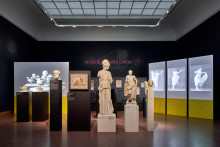8 March 2023 to 21 January 2024
The Liebieghaus Skulpturensammlung devoted an exhibition to one of the most exciting connections in the history of mankind—the connection between art and technology. It is a global narrative, full of cryptic fables, myths and visions, fictive and real innovations and outstanding masterworks. The exhibition shed light on the history of the sciences in antiquity and the Arabic and Asiatic cultures and their influence on the development of art. Technology and art were closely intertwined in antiquity. The Greek term “techne” stands for all “arts”—engineering, construction, et cetera. Primarily, it concerns the knowledge and study of the human mind. Scientific research was pursued with the aim of advancing the human civilization and culture. Whether the pyramids by the ancient Egyptian mastermind Imhotep, the mechanical automata and animated sculptures described by the Greek author Heron or experiments with the first camera obscura by the Arab mathematician Alhazen—they all exemplify how scientific and artistic work go hand in hand.
The Frankfurt exhibition featured 97 prominent objects from international museum collections such as the Museo Archeologico Nazionale in Naples, The Metropolitan Museum of Art in New York, the Musei Capitolini in Rome and the Kunsthistorisches Museum in Vienna, as well as from the Liebieghaus Skulpturensammlung’s own holdings, including the “Statuette of Imhotep” (Egypt, 332–30 BC), the “Statue of Athena” (Roman, AD 1st c.), the “Buddha head” (Cambodia, Angkor Wat, end of 12th–beg. of 13th c.), a “Universal Astrolabe” (by Aḥmad ibn as-Sarrāǧ, Syria, 1328–1329), the “Maria Immaculata” (by Matthias Steinl, Vienna, 1688) and the “Apollo Kithara” (by Jeff Koons, 2019–2022). The multimedia exhibition architecture transformed the entire Liebieghaus into a museum in which art and science of more than five millennia came to life.
Curator: Prof. Dr. Vinzenz Brinkmann (Head of the Department of Antiquities and Asia, Liebieghaus Skulpturensammlung)
Project management: Jakob Salzmann, assistant curator (Department of Antiquities and Asia, Liebieghaus Skulpturensammlung)
Sponsored by: Art Mentor Foundation Lucerne, Gemeinnützige Kulturfonds Frankfurt RheinMain GmbH, Freunde der Tat des Städelschen Museums-Vereins e. V.
With additional support from: Stiftung Polytechnische Gesellschaft Frankfurt am Main
Media partner: Frankfurter Rundschau
Cultural partner: hr2-kultur





